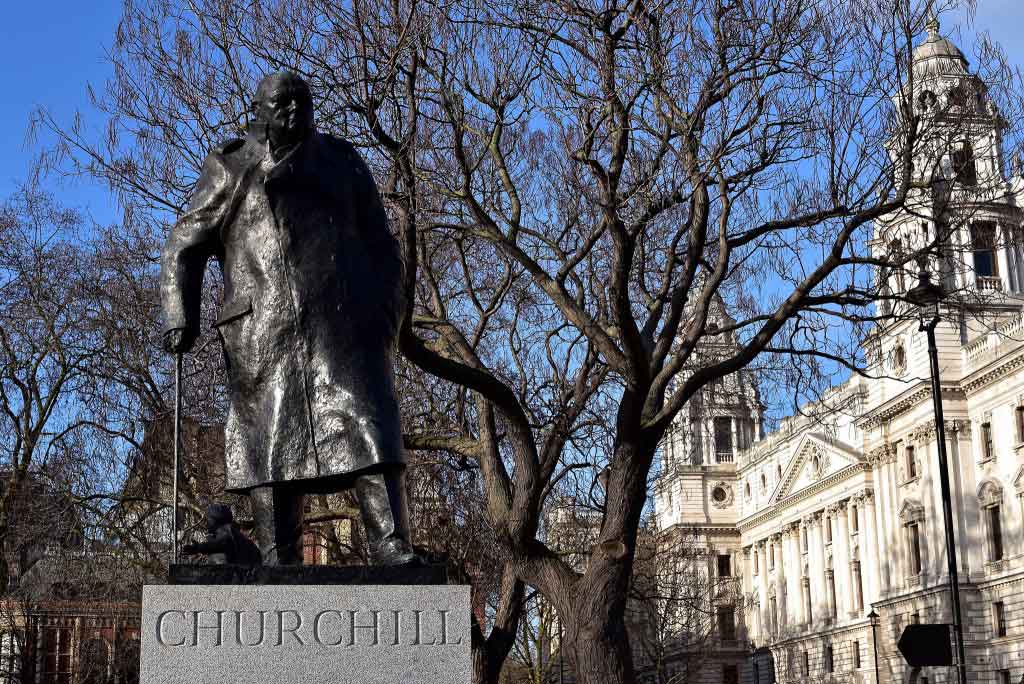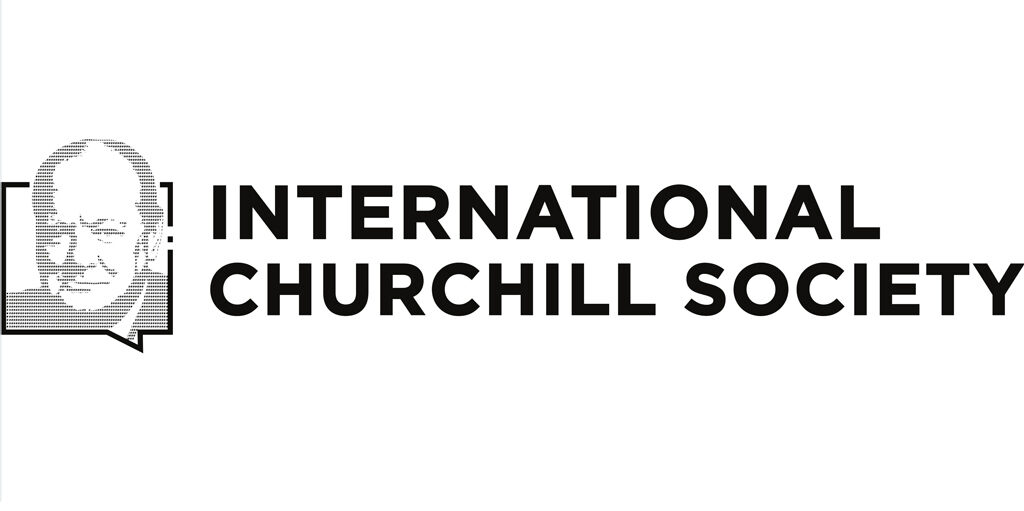
Finest Hour 159
Churchill Proceedings – Canada and the Battle of the Atlantic

Winston Churchill, Parliament Square, London © Sue Lowry & Magellan PR
March 15, 2015
Finest Hour 159, Summer 2013
Page 56
By David Boler
29Th International Churchill conference, Toronto, Ontario, October 2012
At the Going down of the Sun, and in the Morning, We Will Remember Them.

2025 International Churchill Conference
The Battle of the Atlantic was the only campaign of World War II that gave Winston Churchill sleepless nights. As he said at the great moment of crisis in June 1940: “Without victory there is no survival.”
The Battle began on 3 September 1939 and lasted 2074 days until 8 May 1945, when Germany surrendered. The heroes on both sides were the men, the heroines were the ships, and the enemy was the sea: the cruel sea.
Canada’s contribution to the Atlantic battle was inextricably linked to that of Britain’s Royal Navy. Victory in the Atlantic would not win the war for the Allies—but losing it most certainly would have lost the war in Europe.
Both Germany and Britain made strategic mistakes in the 1930s which affected the Atlantic battle. Germany gave priority to building battleships, but would eventually have to turn to the U-boat as its main weapon to starve Britain into surrender. For the Allies, the tide did not turn until they recognized the importance of aircraft in fighting U-boats. Early on, they had placed too much confidence in ASDIC (Allied Submarine Detector Investigation Committee) or, as the Americans knew it SONAR (Sound Navigation and Ranging).
As vital as ASDIC was in the U-boat war, the Germans mostly attacked the convoys on the surface at night, rendering its services useless. Escorts guarding Atlantic convoys needed radar to detect U-boats on the surface.
Churchill would later write that he was mistaken in placing so much faith in the system: “I over-rated, as the Royal Navy did, the magnitude of their achievement in inventing ASDIC, and forgot, for a moment, how broad are the seas.” He added a Churchillian flourish: “However, while ASDIC did not conquer the U-boat, without ASDIC the U-boat would not have been conquered.”
In the British and Canadian Royal Navies, professional careers were made in “big ships.” On smaller ships, newly trained reservist officers only took up their appointments when the ships were ready. Regular Royal Canadian Navy (RCN) officers were kept on shore during the early convoy battles, waiting for the larger cruisers and fleet destroyers to be built and delivered to the “professional” navy.
Captains of British and Canadian convoy escort vessels were mostly officers from merchant ships who were members of their respective naval reserves, or had come from reserve naval units such as the training establishment HMCS York in Toronto. Very few regular RN or RCN officers were in command of escort vessels.
British and Canadian escort ships started the war without radar, and only a handful had a primitive system for locating U-boats. For hunting submerged U-boats they relied on ASDIC, using depth charges to destroy them when found.
Much has been made about the British breaking the German naval codes at Bletchley Park in England, but virtually throughout the war, German cryptanalysts were also breaking British merchant navy codes. The Germans also broke Royal Navy codes on and off into 1943, with disastrous consequences for the Allies.
Despite Canada’s two very long coastlines, it is surprising that in 1939 the RCN had only 1800 regular naval officers and sailors, and the same number of volunteer reservists, with a mere six destroyers and a handful of coastal craft. By 1945, 110,000 men and women had served Canada in what became the world’s third largest navy. It is hardly surprising that such a phenomenal expansion brought severe growing pains which subordinated quality to quantity on too many occasions.
The expansion of the Royal Canadian Navy proceeded at such a pace that any experience gained was promptly diluted by the arrival of new ships, and new, green and untrained crews. Indeed HMCS Chambly, a Canadian corvette which would normally carry a crew of fifty, had 259 men serve aboard during a two-year period: as men gained experience in Atlantic convoys, they were transferred to the new ships being added to the Navy, or posted ashore to train the thousands of new recruits.
Let us now consider the corvette, a major factor in the Atlantic battle. At the outbreak of the war there was a desperate shortage of escort vessels. To fill it, the British Admiralty turned to the 925-ton corvette, based on a design for a whale catcher, originally intended for coastal defence assignments. So desperate was the shortage of destroyers that the corvette was pressed into North Atlantic service, where it soon became the main workhorse for convoy defense.
These small ships were originally designed with a range of 4000 miles and a top speed of 16 knots— critically, not fast enough to outrun a U-boat on the surface. Their armament was a four-inch gun, along with a handful of depth charges.
Corvettes were inexpensive and simple to build, so Canadian shipyards began grinding them out for the Canadian and British navies. The Admiralty named them after flowers, the Canadian navy after cities. Winston Churchill had another name for them: “Cheap and Nasties.” They were cheap to build, and nasty to the enemy.
The first ten Canadian-built corvettes were sailed across the Atlantic to Britain. Such was the shortage of weapons that they sailed without their four-inch deck guns. Some actually had a dummy wooden gun, placed where the real gun would go, no doubt in the hope that it would frighten any U-boat that surfaced in their vicinity.
Corvettes pitched and rolled like corks on the waves. Those who sailed in them said they would roll on wet grass—but they were seaworthy. Their crews were young: both officers and sailors were often just out of high school. From 1941 to the end of 1943, the bulk of the RCN’s war against U-boats was carried out by some seventy of these vessels.
After delivery of the first meaningful number of corvettes in 1941, the RCN’s contribution to the Atlantic battle gained traction. This was abetted by the Newfoundland Escort Force, established under Canadian command.
In his memoirs of the First World War, Churchill wrote that in terms of equipment and armaments, in the first year of the war the armed services would get nothing; in the second year, a trickle; in the third year, nearly all they wanted; and in the fourth year, more than they needed. So it was with the British and Canadian navies in World War II: nothing in 1940; a trickle in 1941; not enough in 1942; all that was needed in 1943, when the back-bone of the U-boat fleet was at last broken.
The Allies realised early that anti-submarine aircraft patrols by RAF and RCAF coastal command, their planes equipped with radar and depth charges, were an effective part of convoy defence; but only very slowly were these patrols expanded. There were no very long range (VLR) aircraft available to close what was known as the “Atlantic Gap”—that part of the ocean beyond the range of shore-based aircraft, where U-boats at first operated with impunity.
In May 1941 a German Enigma coding machine, with all its rotors and code books, was captured by a British destroyer from U-110. As a result, U-boat messages were decoded in real time, and for the rest of 1941 the Admiralty was able to re-route convoys away from known U-boat concentrations, significantly reducing losses.
In July 1941, end-to-end escort of convoys across the Atlantic became possible. American warships escorted them a third of the way, Canadians the middle part of the journey, and British and Canadian vessels covered the remainder of the route to UK ports. Warships were refuelled (dangerously) from tankers in mid-ocean.
U-boats were grouped together in “wolf packs” to attack convoys in larger numbers. Corvettes, and their new lengthened sisters, called frigates, were formed into escort groups to counter the German pack tactics.
One benefit of the Churchill-Roosevelt “Atlantic Meeting” in August 1941 was that the Americans agreed to extend eastward the line behind which they assumed responsibility for the defence of shipping. This gave Canadian and British escort vessels a much-needed respite. Ultimately, the line would extend south from Iceland, turning America into the “neutral belligerent” Churchill hoped would eventually lead the U.S. to enter the war. Ironically, this meant that Canadian warships fighting Germany came under command of the officially neutral U.S. Navy: a risk for which Roosevelt deserved credit.
Even more important was the need for more air support of the convoys. The VLR B-24 Liberator bomber was crucial to the battle, but only a handful were at first used in the anti-submarine role; the majority were used by RAF Bomber Command to attack Germany.
The absence of these aircraft was keenly felt, especially after February 1942, when the Germans added another rotor wheel to the Enigma coding machine, making it impossible to decipher U-boat wireless messages. Intelligence dried up overnight and again the Allies were blind.
During that year, as U-boat strength increased, a number of Canadian-escorted convoys suffered massive losses. The Royal Navy reported to the Canadian Admiralty: “A grave danger exists of breakdown in health, morale and discipline.” Simply put, there were not enough trained men to provide relief; the Canadians were exhausted and their ships had been stretched to the breaking point.
The training base at Halifax left much to be desired. As the Germans moved many U-boats further into the South Atlantic, the British pursued them, and the Canadians were left with yet more responsibility in the North Atlantic. The latter part of 1942 became a slogging match: sometimes the U-boats, and sometimes the escorts, got the upper hand. Losses spiraled, and one Allied convoy lost more than three-quarters of its ships.
As the British Admiralty began looking for ways to improve the quality of escort forces, it considered the RCN the weakest link in its defences. The Canadians were providing 48% of the escorts, but in 1942 Canadian-escorted convoys were suffering 80% of the shipping losses. In fairness, Canadian escorts were mostly allocated to the slower convoys, exposing them to greater risk. And the Canadians also had their successes: half the U-boats sunk in mid-Atlantic in 1942 were sent to the bottom by Canadian warships.
Canada, too, was new to large-scale shipbuilding, and to the manufacture of vital equipment such as radar. Canadians were always at the back of the queue for the latest technical advances. They were given no VLR B-24 Liberators or radar sets, most of their destroyers were old, and their corvettes had not been much improved from the original design, which was highly uncomfortable to the crews.
Very slowly, Canadian escorts were refitted with modern equipment needed to fight the U-boats successfully. They were also temporarily reinforced by British destroyers, and increasingly were given fast convoys to protect, reducing their exposure to risk. By March 1943, the four Canadian groups based in Londonderry, Northern Ireland, were receiving individual and group training between convoy duty at sea. They returned to the Atlantic battle in time for its climax that May.
A turning point was reached in December 1942. After a year of being unable to read U-boat wireless messages, British cryptanalysts broke the new German code (called “Shark” by the British and “Triton” by the Germans). Again the Allies were able to read U-boat messages in “real time.” The crux of the U-boat war was at hand. Which side would prevail?
The issue was in doubt: In the winter of 1942-43, a quarter of the ships in four full-laden eastbound convoys were torpedoed and lost in a howling gale. Early 1943 saw the heaviest losses in the war: 22% of all merchant ships sailing in January-May failed to arrive at their destination. These were critical losses.
Canada’s contribution to the Allied naval effort— unglamorous, hard and costly—was rewarded by the creation of the country’s first independent operational command, “Canadian North West Atlantic,” under a Canadian Admiral.
A continuing problem in 1943 was the shortage of Liberators to close the mid-Atlantic air gap, placing thousands of merchant ships in grave danger. But at Casablanca in January, Roosevelt and Churchill decided to divert aircraft from other theaters, and by May 1943 their move had proven decisive. Forty-three U-boats, with an average crew of forty, were sunk by aircraft and warships.
The German U-boat arm was now doomed. The air gap was closed; ships and aircraft now had sophisticated radar and radio direction finders and better armaments; there were sufficient escort ships with well-trained Canadian, American and British crews; and Enigma messages were being read to good effect.
In June, the Germans ordered all submarines back to their French bases. When they did venture out again, their losses were unsustainable.
Air power, ships and technology had rendered the U-boat fleet obsolete. Admiral Doenitz, by then head of the Germany Navy, would have been dismayed to have learned that in October 1943, Allied shipbuilding (now overwhelmingly American) had finally exceeded the tonnage lost to U-boats. The Americans were building Liberty ships from start to finish in ten days, launching three a day.
In the last two years of the war, Canadian frigates and corvettes were conceded to be the best afloat, and the Maple Leaf funnel emblem indicated new pride in their nationality. By 1944, wrote then-Commander, later Admiral Peter Gretton, “the RCN was carrying the main burden of the mid-Atlantic war, and well she did it.”
By then the Royal Canadian Navy had fulfilled many long-cherished dreams, with modern cruisers, fleet-class destroyers, and light aircraft carriers. But the Canadian Admiralty had maintained that attacking U-boats and guarding convoys was suitable work only for reservists and wartime volunteers—and that work was indeed left to them.
Between 1940 and 1945, Canadian warships escorted more than 25,000 merchant ships carrying almost 200 million tons of food and war materials from North America to Britain. In the process, the Allies lost 2600 merchant ships, of which nearly 13.5 million tons was to submarines.
Canadian merchant seamen suffered heavily, losing one in ten among the 12,000 who had served. Combined, the Allied navies had lost about 20,000 officers and men in convoy escorts. The RCN sustained 1965 casualties, with the loss of twenty-four warships in the North Atlantic and Gulf of St. Lawrence.
On the German side, of 1162 U-boats involved in the Battle of the Atlantic, 784 were destroyed—a staggering 70%. Of the 40,000 Germans who sailed on wartime voyages, more than 30,000 became casualties, a loss approaching eight out of ten. One calculation holds that the RCN and RCAF jointly sank forty-seven U-boats in the North Atlantic.
Canada clearly made an enormous effort in this grave and portentous battle for supremacy. It is left for us today to pay tribute to all the brave Canadians who fought, particularly the 2000 who died. We should remember that they were volunteers—as were the Canadian fighter pilots who fought in the skies above Southeast England in the Battle of Britain; the thousand Canadian boys who died on the dreadful shingle beach at Dieppe in 1942; who fought up the spine of Italy and fell storming Ortona in 1943; who died on sandy Juno Beach on D-Day, and the subsequent, very bloody Normandy campaign; who perished on the cusp of victory in March and April 1945 while liberating Holland and Belgium.
All volunteers. Honour to their bravery, their courage, their sacrifice.
Mr. Boler ([email protected]) is a former chairman of The Churchill Centre UK, and has chaired or co-chaired several international conferences since the early 1990s. He is writing a book on the Battle of the Atlantic and his father’s experiences sailing aboard Canadian corvettes.
Subscribe
WANT MORE?
Get the Churchill Bulletin delivered to your inbox once a month.



